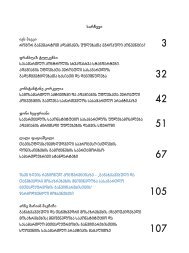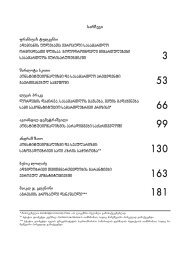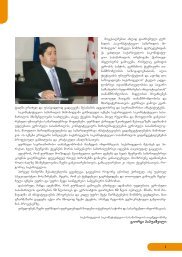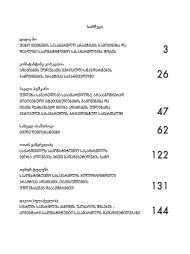Contents - Constitutional Court of Georgia
Contents - Constitutional Court of Georgia
Contents - Constitutional Court of Georgia
Create successful ePaper yourself
Turn your PDF publications into a flip-book with our unique Google optimized e-Paper software.
The European <strong>Court</strong><strong>of</strong> Human Rights is Fifty. Recent trends in the <strong>Court</strong>’s jurisprudence<br />
Couldn’t we, perhaps shouldn’t we, forget it? as M. van de Kerchove and F. Ost rightly ask<br />
themselves in From the pyramid to the network? Towards a new way <strong>of</strong> establishing the<br />
law. 116<br />
B. The international level<br />
The European Convention on Human Rights and Fundamental Freedoms is not only the<br />
first instrument, but is also the most fundamental since, in terms <strong>of</strong> effectiveness, the Convention<br />
<strong>of</strong>fers the fullest protection, the rights it guarantees being actionable (“justiciable”),<br />
that is to say they may form the subject-matter <strong>of</strong> recourse before a wholly judicial<br />
body, the new European <strong>Court</strong> <strong>of</strong> Human Rights established on 1 November 1998. In more<br />
general terms, the ability to assert human rights before a court is the primary prerequisite<br />
for their effectiveness.<br />
As far as the mechanism <strong>of</strong> the European <strong>Court</strong> is concerned, I will highlight five recent<br />
trends.<br />
1.THE SCOPE OF JURISDICTION<br />
The European <strong>Court</strong> receives more and more cases directly involving European Community<br />
and European Union Law and acts <strong>of</strong> European institutions. The case <strong>of</strong> “Bosphorus<br />
Airways” v. Ireland concerns an aircraft leased by the applicant company from Yugoslav<br />
Airlines and seized by the Irish authorities under an EC Council Regulation which, in turn,<br />
had implemented the UN sanctions regime against the Federal Republic <strong>of</strong> Yugoslavia (Serbia<br />
and Montenegro). The applicant’s challenge to the retention <strong>of</strong> the aircraft was initially<br />
successful in the High <strong>Court</strong>, which held in June 1994 that the relevant Council Regulation<br />
was not applicable to the aircraft. However, on appeal, the Supreme <strong>Court</strong> referred a preliminary<br />
question under Article 177 <strong>of</strong> the EEC Treaty to the European <strong>Court</strong> <strong>of</strong> Justice on<br />
whether the applicant’s aircraft was covered by the relevant Council Regulation. The answer<br />
was in the affirmative and by a judgment dated November 1996 the Supreme <strong>Court</strong><br />
applied the decision <strong>of</strong> the European <strong>Court</strong> <strong>of</strong> Justice and allowed the State’s appeal. The<br />
applicant complains under Article 1 <strong>of</strong> Protocol no. 1 (protection <strong>of</strong> property) to the Euro-<br />
116 M. van de Kerchove and F. Ost, “De la pyramide au réseau ? Vers un nouveau mode de production du droit”, Revue interdisciplinaire<br />
d’études juridiques, 2000, pp. 1-82 ; M. van de Kerchove and F. Ost, De la pyramide au réseau. Pour une théorie dialectique du droit, Brussels,<br />
Publications des Facultés universitaires Saint-Louis, 2002.<br />
35






